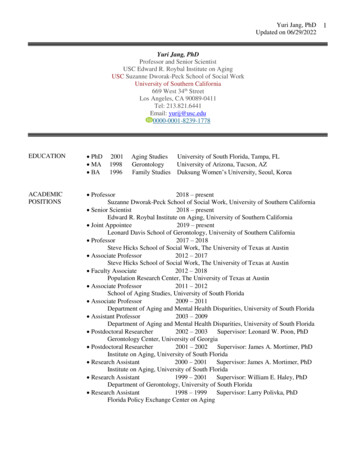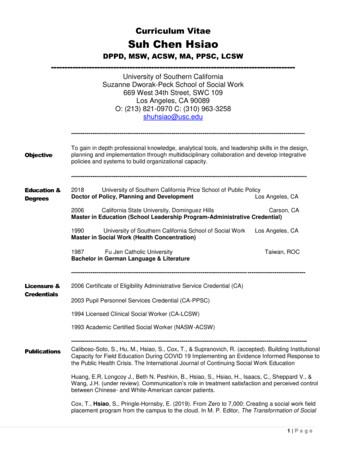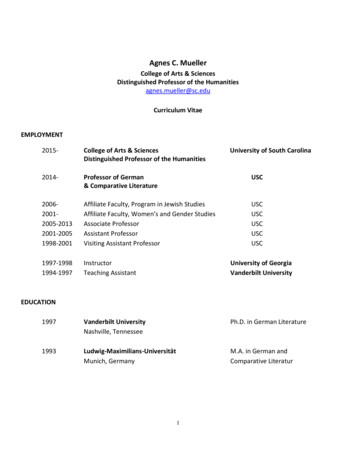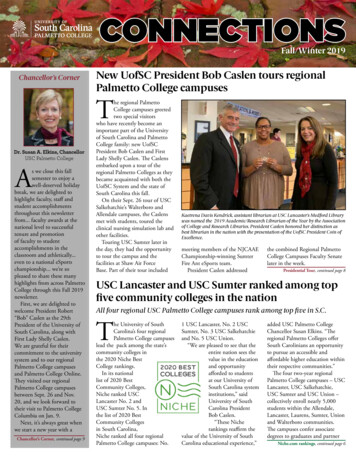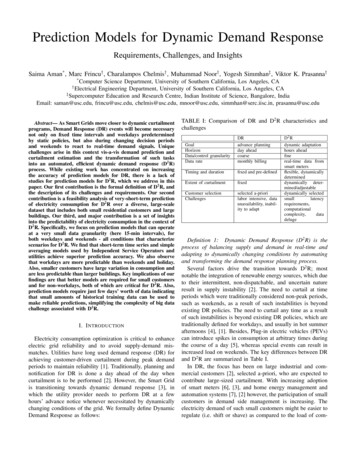
Transcription
Suzanne L. WenzelAugust 2012CURRICULUM VITAESuzanne L. Wenzel, Ph.D.Professor, School of Social Work andDepartment of PsychologyUniversity of Southern California669 West 34th StreetLos Angeles, CA 90089-0411Phone: 213-740-0819E-mail: swenzel@usc.eduEducation1981-1985B.A. (summa cum laude), Geography and Urban/Regional Planning(minor: Psychology), Texas State UniversityHonors: National Geographic Education Association,Outstanding Senior Award1986-1990Ph.D., Community Psychology, The University of Texas at AustinService: Graduate Student Council; Affirmative Action andFaculty-Student Relations Committees1990-1993National Institute of Mental Health (NIMH) Postdoctoral Fellowship,Rutgers/Princeton Program in Mental Health Research and UCLADepartment of SociologyRecent HonorsRAND Corporation President’s Award for Research, 2007“ for her far-reaching research on the problems of substance abuse, health carefor indigent persons, and homelessness, as well as her creative efforts to develop astrong funding base for research on domestic violence.”Fellow, Association for Psychological Science, elected 2008:“ for sustained outstanding contributions to the science of psychology.”RAND Corporation Merit Award, 2008“ for her extraordinary service in upholding RAND’s quality standards and inrevising Health quality assurance policies and processes.”1
Suzanne L. WenzelAugust 2012Fellow, Western Psychological Association, 2010“ in recognition of outstanding and unusual contributions to the science andprofession of psychology.”Sterling C. Franklin Award for Distinguished USC School of Social Work Faculty, 2011“ for excellence in research and scholarship; service to the university, theschool, and the community; and accessibility to students.”Research Projects1988-1989Consultant, "Demonstration of Team Case Management to Provide JobTraining Activities for the Homeless," (U.S. Department of Labor)1995Co-Principal Investigator (L. Gelberg, PI), “Antecedents and Consequences ofVictimization Among Homeless Adults” (UCLA/Centers for Disease Control)1995-1998Project Director, “Access to Care for Homeless Women of Reproductive Age”(R01, Agency for Health Care Policy and Research)1997-2000Investigator, “RAND/Phoenix House Research Partnership” (PhoenixHouse Foundation)1998-1999Co-Principal Investigator (P. Ebener, PI), “Understanding Needs andOutcomes of Substance Abuse Treatment for Juvenile Offenders: JuvenileAccountability Incentive Block Grant Program” (National Institute of Justice,NIJ)1998 -1999Principal Investigator, “Violence Against Homeless Women: Risk Factorsand Health Consequences” (The Commonwealth Fund – Total costs: 50,000)1999-2000Key Investigator, “Public Sector Costs for Homeless Alcoholics” (NationalInstitute on Alcohol Abuse and Alcoholism, NIAAA)1999-2000Investigator and Project Manager, “National Evaluation of Drug Courts”(National Institute of Justice)1999-2000Local site (Los Angeles) Investigator/Evaluator, U.S. Substance Abuse andMental Health Services Administration “Women and Violence InitiativeEvaluation” (Substance Abuse and Mental Health Services Administration,SAMHSA)1999-2001Principal Investigator, “Collaborative Linkages Between Drug Courts andService Providers” (R01 DA 13097 - National Institute on Drug Abuse, NIDA –Total costs: 293,295)1999-2005Principal Investigator, “Drug Abuse, Violence, and HIV/AIDS in ImpoverishedWomen” (R01 DA 11370 - NIDA – Total costs: 1,959,711)2
Suzanne L. WenzelAugust 20122000-2002Consultant (no remuneration), "Substance Abuse Treatment in Two ManagedCare Structures" (NIDA)2000-2005Principal Investigator, “AIDS Supplement” (to Drug Abuse, Violence, andHIV/AIDS in Impoverished Women - R01 DA 11370 - NIDA – Total costs: 303,959)2000-2003Co-Principal Investigator (K. Watkins, PI), “Improving Care for Co-OccurringMental Health Disorders in Substance Abuse Treatment Settings” (SAMHSA)2001-2007Principal Investigator, "Quality of Care in the Therapeutic Community"(R01 DA014969 - NIDA – Total costs: 2,772,744)2002-2006Co-Principal Investigator (J. Tucker, PI), “Interpersonal Context of HIV Risk inImpoverished Women” (R01 HD041712), National Institute on Child Health andHuman Development, NICHD)2004-2006Investigator, “The Role of Trauma Exposure in Drug Use and HIV Risk”(National Institute of Mental Health, NIMH)2004-2007Principal Investigator, “Prevention for Impoverished Young Women inShelters” (R21 DA019183 - NIDA – Total costs: 519,205)2005-2007Principal Investigator, “Residential Status, Drug Use, Health AmongImpoverished Women” (R03 DA020387 - NIDA – Total costs: 194,314)2005-2010Principal Investigator, “Alcohol Use and HIV Risk Among ImpoverishedWomen” (R01 AA015301 – National Institute on Alcohol Abuse andAlcoholism, NIAAA – Total costs: 2,779,975)2005-2010Co-Principal Investigator (K. Watkins, PI), “Group CBT for Clients withDepression in AOD Treatment” (R01 AA014699 – NIAAA)2005-2007Senior Consultant (no remuneration), "Bayesian Pattern-Mixture Models forQuality of Care Data" (R03 HS014805 – Association for Health ResearchQuality)2006-2009Principal Investigator, “Cognitive Behavioral Therapy for Homeless Women withPTSD” (R34 MH076099 – National Institute of Mental Health, NIMH– Totalcosts: 862,557)2006-2012Co-Principal Investigator (J. Tucker, PI), “Drug Use, Social Context, and HIVRisk in Homeless Youth” (R01 DA020351 – NIDA)2007-2011Senior Consultant, “Brief Substance Use Intervention for Youth in Teen Court”(R01DA019938 – NIDA)2007-2008Task lead (Phase 3 Client Survey), (PIs: Pincus, Watkins), “Evaluation ofServices for Seriously Mentally Ill Patients in the Veterans Health Administrationof the Department of Veterans Affairs” (Department of Veterans Affairs)2008-2011Senior Consultant (no remuneration), “Assessment of the Adolescent TherapeuticCommunity Treatment Process” (R21DA021569 – NIDA)3
Suzanne L. WenzelAugust 20122009-2012Principal Investigator, “Heterosexual HIV Risk Behavior in Homeless Men”(R01HD059307 – Eunice Kennedy Shriver National Institute for Child Healthand Human Development (NICHD, funded October 2009)-- Total costs: 1,973,943).2010-2011Principal Investigator, “Homeless Veterans in Skid Row: Understanding andAddressing Behavioral Health Needs” (USC Keck School of Medicine, Clinicaland Translational Science Institute) (Total costs: 35,000)2011-2013Principal Investigator, “Homelessness in Los Angeles: Collaboration to FosterInnovative Solutions. J. Scott and Obaida Watt (Total costs: 100,000).2012-2014Principal Investigator, “Adapting an EBI for HIV Sexual Risk Prevention forHomeless Women” (NIDA, funded March 2012) Total costs: 489,000)2012-2017Principal Investigator (USC subcontract), “Partnerships to Demonstrate theEffectiveness of Supportive Housing for Families in the Child Welfare System(LA County)” (U.S. DHHS, Administration on Children, Youth, and Families -Children’s Bureau) Total evaluation subcontract costs: 1,176,337 (Proposalunder review)Publications in Peer-Reviewed Journals (in reverse chronological order)* Denotes publications from projects on which Wenzel is the P.I.De la Haye, K., Green, H., Kennedy, D, Wenzel, S. & Tucker, J.S. Who is supporting homelessyouth? Predictors of support in personal networks. (Accepted for publication, Journal ofAdolescence).* Wenzel, S.L., Hsu, H., Zhou, A., Tucker, J.S. (in press). Are social network correlates of heavydrinking similar among Black homeless youth and White homeless youth. Journal of Studieson Alcohol and Drugs.* Tucker, J.S., Wenzel, S.L., Golinelli, D., & Munjas, B. Understanding heterosexual condom useamong homeless men: An event-based study.* Golinelli, D., Ridgeway, G., Rhoades, H.R., Tucker, J.S., Wenzel, S.L. (in press). Bias andvariance trade-offs when combining propensity score weighting and regression: application toHIV status and homeless men. Health Services and Outcomes Research Methodology.* Wenzel, S.L., Rhoades, H., Golinelli, D., Kennedy, D.P., Zhou, A., & Ewing, B. (2012). HIVrisk behavior and access to services: What predicts HIV testing among heterosexually-activehomeless men? AIDS Education and Prevention, 24(3), 270-279.Tucker, J.S., Sussell, J., Golinelli, D., Zhou, A., Kennedy, D., & Wenzel, S.L. (in press).Understanding pregnancy-related attitudes and behaviors: A mixed method study of homelessyouth. Perspectives on Sexual and Reproductive Health.4
Suzanne L. WenzelAugust 2012Tucker, J.S., Hu, J., Golinelli, D., Kennedy, D.P., Wenzel, S.L. (in press). Social networks andindividual predictors of sexual risk behavior among homeless young MSM. Journal ofAdolescent Health.* Kennedy, D.P., Brown, R., Wenzel, S.L., & Tucker, J.S. (in press). Masculinity and sexual riskamong homeless men in Los Angeles. Psychology of Men and Masculinity.* Green, H.D., Tucker, J.S., & Wenzel, S.L., Golinelli, D. (2012). Association of childhoodemotional, physical, and sexual abuse with the structure and content of homeless women'ssocial networks. Child Abuse and Neglect, 36(1), 21-31.* Wenzel, S.L., Rhoades, H., Hsu, H., Golinelli, G., Tucker, J.S., Kennedy, D.P., & Ewing, B.(2011). Behavioral health and social normative influence: Correlates of concurrent sexualpartnering among heterosexually active homeless men. (online: DOI 10.1007/s10461-0110066-0) AIDS and Behavior.Tucker, J.S., Ryan, G., Golinelli, D., Munjas, B. & Wenzel, S.L. (in press). Substance use and otherrisk factors for unprotected sex: Results from an event-based study of homeless youth. AIDSand Behavior.Wenzel, S.L., Holloway, I., Golinelli, D., Bowman, R., & Tucker, J. (2011). Social networks ofhomeless youth in emerging adulthood. (online: DOI 10.1007/s10964-011-9709-8) Journal ofYouth and Adolescence.* Brown, R., Kennedy, D., Tucker, J., Ryan, G., & Wenzel, S.L. (2011). Sex and relationships onthe street: How homeless men judge partner risk on Skid Row. AIDS and Behavior, 16(3),774-784.Martino, S., Tucker, J.S., Wenzel, S.L., Ryan, G., Golinelli, D., & Munjas, B. (in press). Increasedsubstance use and risky sexual behavior among migratory homeless youth: Exploring the roleof social network composition. Journal of Youth and Adolescence.* Rhoades, H., Wenzel, S.L., Golinelli, D., Tucker, J., Kennedy, D., Green, H., & Zhou, A.(in press). The social context of homeless men’s substance use. Drug and AlcoholDependence.* Tucker, J.S., Wenzel, S.L., Golinelli, D., Zhou, A., & Green, H.D. (2011). Predictors of substanceabuse treatment need and receipt among homeless women. Journal of Substance AbuseTreatment, 40, 287–294.Wenzel, S.L., Tucker, J.S., Golinelli, D., Green, H.D., & Zhou, A. (2010). Personal networkcorrelates of alcohol, cigarettes, and marijuana use among homeless youth. Drug and AlcoholDependence, 112, 140–149.* Golinelli, D., Ryan, G., Green, H.D., Kennedy, D.P., Tucker, J., & Wenzel, S.L. (2010). Samplingto reduce respondent burden in personal network studies and its effect on estimates of structuralmeasures. Field Methods, 22(3) 217-230.5
Suzanne L. WenzelAugust 2012* Kennedy, D.P., Wenzel, S.L., Tucker, J.S., Green, H.D., Golinelli, D., Ryan, G., Beckman, R.,& Zhou, A. (2010). Unprotected sex of homeless women living in Los Angeles County: Aninvestigation of the multiple levels of risk. AIDS and Behavior, 14(4), 960-973.* Tucker, J.S., Wenzel, S.L., Golinelli, D., Ryan, G., Zhou, A., Beckman, R., Kennedy, D.P. &Green, H.D. (2010). Is substance use a barrier to protected sex among homeless women?:Results from between- and within-subjects event analyses. Journal of Studies on Alcohol andDrugs, 71 (1), 86-94.* Wenzel, S.L., Green, H.D., Tucker, J.S., Golinelli, D., Kennedy, D.P., Ryan, G., Zhou, A. (2009).The social context of homeless women’s alcohol and drug use. Drug and Alcohol Dependence,105(1-2), 16-23.* Ryan, G., S.A. Stern, L. Hilton, J.S. Tucker, D.P. Kennedy, D. Golinelli, & Wenzel, S. L. (2009).When, where, why and with whom homeless women engage in risky sexual behaviors: Aframework for understanding complex decision-making processes. Sex Roles. Publishedonline, July 31, 2009, doi: 10.1007/s11199-009-9610-z.* Wenzel, S.L., D’Amico, E., Barnes, D., & Gilbert, M.L. (2009). A pilot of a tripartite preventionprogram for homeless young women in the transition to adulthood. Women’s Health Issues,19(3), 193-201.* D’Amico, E. J., Barnes, D., Gilbert, M. L., Ryan, G., & Wenzel, S. L. (2009). Developing atripartite prevention program for impoverished young women transitioning to adulthood:Addressing substance use, HIV risk, and victimization by intimate partners. Journal ofPrevention and Intervention in the Community, 37(2), 112-128.* Tucker, J.S., Kennedy, D., Ryan, G., Wenzel, S.L., Golinelli, D., & Zazzali, J. (2009). Homelesswomen’s personal network: Implications for understanding risk behavior. HumanOrganization, 68(2), 129-140.* Golinelli, D., Longshore, D., & Wenzel, S.L. (2009). Substance use and intimate partner violence:Clarifying the relevance of women’s use and partners’ use. Journal of Behavioral HealthServices & Research, 36(2), 199-211.* Miles, J., Mandell, W., & Wenzel, S. L. (2008). The relationship between the dimensions ofchange instrument and retention in therapeutic community treatment: The moderating influenceof time in treatment. The American Journal of Drug and Alcohol Abuse, 34(6), 667-672.* Mandell, W., Edelen, M.O., Wenzel, S.L., Dahl, J., & Ebener, P. (2008). Do dimensions of TCtreatment predict retention and outcomes? Journal of Substance Abuse Treatment, 35(3), 223231.* Edelen, M. O., Miles, J. N. V., Osilla, K. C., & Wenzel, S. L. (2008). Further validity evidence forthe dimensions of change in Therapeutic Community Treatment Instrument. American Journalof Drug and Alcohol Abuse, 34(3), 285-292.6
Suzanne L. WenzelAugust 2012* Wenzel, S.L., Tucker, J.S., Elliott, M.N., & Hambarsoomian, K. (2007). Sexual risk amongimpoverished women: Understanding the role of housing status. AIDS and Behavior, 9; S9S20.* Paddock, S.M., Edelen, M.O., Wenzel, S.L., Ebener, P., Mandell, W., & Dahl, J. (2007).Measuring changes in client-level treatment process in the therapeutic community with theDimensions of Change Instrument. American Journal of Drug and Alcohol Abuse, 33(4), 537546.McNeese-Smith, D., Nyamathi, A., Longshore, D., Wickman, M., Robertson, S., Obert, J.,McCann, M., Wells, K., & Wenzel, S. (2007). Processes and outcomes of substance abusetreatment in two programs among clients insured under managed care. American Journal ofDrug and Alcohol Abuse, 33; 439-446.* Tucker, J.S., Elliott, M.N., Wenzel, S.L., & Hambarsoomian, K. (2007). Relationshipcommitment and its implications for unprotected sex among impoverished women living inshelters and low-income housing in Los Angeles County. Health Psychology, 26 (5); 644649.* Edelen, M.O., Tucker, J.S., Wenzel, S.L., Paddock, S., Ebener, P.A., Dahl, J., & Mandell, W.(2007). Treatment process in the therapeutic community: Associations with retention andoutcomes among adolescent residential clients. Journal of Substance Abuse Treatment, 32(4),415-421.* Chan, K.S., Wenzel, S.L., Mandell, W., Orlando, M., & Ebener, P. (2007). Are prisonercharacteristics associated with therapeutic community treatment process? American Journal ofDrug and Alcohol Abuse, 33(2), 267-279.* Orlando, M., Wenzel, S.L., Ebener, P., Edwards, M.C., Mandell, W., & Becker, K. (2006). TheDimensions of Change in Therapeutic Community Treatment Instrument. PsychologicalAssessment, 18(1), 118-122.* Tucker, J.S., Wenzel, S.L., Elliott, M.N., & Hambarsoomian, K. (2006). Predictors ofunprotected sex with non-cohabitating primary partners among sheltered and low-incomehoused women in Los Angeles County. Journal of Health Psychology, 11(5), 697-710.* Wenzel, S.L., Tucker, J.S., Hambarsoomian, K., & Elliott, M.N. (2006). Toward a morecomprehensive understanding of violence against impoverished women. Journal ofInterpersonal Violence, 21(6), 820-839.* Wenzel, S.L., Hambarsoomian, K., D'Amico, E.J., Ellison, M., & Tucker, J.S. (2006).Victimization and health among indigent young women in the transition to adulthood: Aportrait of need. Journal of Adolescent Health, 38(5), 536-543.* Elliott, M.N., Golinelli, D., Hambarsoomian, K., Perlman, J., & Wenzel, S.L. (2006). Samplingwith field burden constraints: An application to sheltered homeless and low income housedwomen. Field Methods, 18, 43-58.7
Suzanne L. WenzelAugust 2012Hunter, S., Watkins, K., Wenzel, S., Gilmore, J., Sheehe, J., & Griffin, B. (2005) Trainingsubstance abuse treatment staff to care for co-occurring disorders. Journal of Substance AbuseTreatment, 28, 239-245.* Rayburn, N.R., Wenzel, S.L., Elliott, M.N., Hambarsoomian, K., Marshall, G.N., & Tucker, J.S.(2005). Trauma, depression, coping, and mental health service seeking among impoverishedwomen. Journal of Consulting and Clinical Psychology, 73(4), 667-677.* Tucker, J.S., D'Amico, E.J., Wenzel, S.L., Golinelli, D., Elliott, M.N., & Williamson, S. (2005).A prospective study of risk and protective factors for substance use among women living intemporary shelters in Los Angeles County. Drug and Alcohol Dependence, 80, 35-43.* Tucker, J.S., Wenzel, S.L., Straus, J., Ryan, G.W., Golinelli, D., & Elliott, M.N. (2005).Experiencing interpersonal violence: Perspectives of sexually active, substance-usingwomen living in shelters and low-income housing. Violence Against Women, 11, 13191340.* Chan, K., Wenzel, S.L., Orlando, M., Montagnet, C., Mandell, W., Becker, K., & Ebener, P.(2004). How important are client characteristics to understanding treatment process in thetherapeutic community? American Journal of Alcohol and Drug Abuse, 30(4), 867-887.* Tucker, J.S., Wenzel, S.L., Elliott, M.N., Marshall, G.N., & Williamson, S. (2004). Interpersonalviolence, substance use, and HIV-related behavior and cognitions: A prospective study ofimpoverished women in Los Angeles County. AIDS and Behavior, 8(4), 463-474.Watkins, K.E., Hunter, S., Wenzel, S.L., Tu, W., Paddock, S., Griffin, B., & Ebener, P. (2004).Prevalence and characteristics of clients with co-occurring disorders in outpatient substanceabuse treatment. American Journal of Alcohol and Drug Abuse, 30(4), 749-764.* Wenzel, S.L., Tucker, J.S., Elliott, M.N., Marshall, G.N., Williamson, S.L. (2004). Physicalviolence against impoverished women: A longitudinal analysis of risk and protective factors.Women's Health Issues, 14(5), 144-154.* Wenzel, S.L., Tucker, J., Elliott, M., Hambarsoomian, K., Perlman, J., Becker, K., Kollross, C., &Golinelli, D. (2004). Prevalence and co-occurrence of violence, substance use and disorder, andHIV risk behavior: A comparison of sheltered vs. low-income housed women in Los AngelesCounty. Preventive Medicine, 39(3);617-624.* Wenzel, S., Turner, S., Ridgely, M. S. (2004). Collaborations between drug courts and serviceproviders: Characteristics and challenges. Journal of Criminal Justice, 32 (3), 253-263.* Tucker, J.S., Wenzel, S.L., Elliott, M.N., Hambarsoomian, K., & Golinelli, D. (2003). Patternsand correlates of HIV testing among sheltered and low-income housed women. Journal ofAcquired Immune Deficiency Syndromes, 34(4), 415-422.Herndon, B., Asch, S., Kilbourne, A., Wang, M., Lee, M., Wenzel, S., Andersen, R., & Gelberg, L.(2003). Prevalence and predictors of HIV testing among a probability sample of homelesswomen in Los Angeles County. Public Health Reports, May-June (118), 261-269.8
Suzanne L. WenzelAugust 2012Bird, C. E., Jinnett, K. J., Burnam, M. A., Koegel, P., Sullivan, G., Wenzel, S. L., Ridgely, S.,Morton, S. C., & Miu, A. (2002). Predictors of contact with public service sectors amonghomeless adults with and without alcohol and drug disorders. Journal of Studies on Alcohol,63 (6), 716-725.Turner, S., Longshore, D., Wenzel, S., Deschenes, E., Greenwood, P., Fain, T., Harrell, A., Morral,A., Taxman, F., Iguchi, M., Greene, J. & McBride, D. (2002). A decade of drug treatmentcourt research. Substance Use and Misuse, 37 (12-13), 1489-1529.Luck, J., Andersen, R., Wenzel, S., Arangua, L., Wood, D., Gelberg, L. (2002). Providers ofprimary care to homeless women in Los Angeles County. The Journal of Ambulatory CareManagement, 25 (2), 53-67.Kilbourne, A., Herndon, B., Andersen, R., Wenzel, S. & Gelberg, L. (2002). Psychiatric symptoms,health services, and HIV risk factors among homeless women. Journal of Health Care for thePoor and Underserved, 13(1). 49-65.Wenzel, S.L., Burnam, M.A., Koegel, P., Miu, A., Morton, S., Jinnett, K. & Sullivan J.G. (2001).Access to inpatient or residential treatment for substance abuse among homeless adults withalcohol or other drug use disorders. Medical Care, 39(11), 1158-1169.Nyamathi, A., Wenzel, S., & Leake, B. (2001). Comparison of victimized and non-victimizedhomeless women: The psychosocial and behavioral profile of women and their intimatepartners. Research in Nursing and Health, 24, 324-335.Wenzel, S., Leake, B., Andersen, R., & Gelberg, L. (2001). Utilization of birth control servicesamong homeless women. American Behavioral Scientist, 45(1), 14-34.* Wenzel, S., Leake, B., & Gelberg, L. (2001). Risk factors for major violence among homelesswomen. Journal of Interpersonal Violence, 16(8), 739-752.Wenzel, S., Andersen, R., Gifford, D., & Gelberg, L. (2001). Homeless women’s gynecologicalsymptoms and use of medical care. Journal of Health Care for the Poor and Underserved,(12)3, 323-341.* Wenzel, S., Turner, D., Longshore, D., & Ridgely, M. (2001). Drug courts: A bridge betweencriminal justice and health services. Journal of Criminal Justice, 29(3), 241-253.Gelberg, L., Robertson, M., Leake, B., Wenzel, S., Bakhtiar, L., Hardie, E., Sadler, N. & Getzug, T.(2001). Hepatitis B among homeless and other impoverished US military veterans inresidential care in Los Angeles. Public Health (Journal of the Royal Institute of Health &Hygiene and the Society of Public Health), 115, 286-291.Gelberg, L., Leake, B., Lu, M., Andersen, R., Wenzel S., Morgenstern, H., Koegel, P., & Browner,C. (2001). Use of contraceptive methods among homeless women for protection againstunwanted pregnancies and sexually transmitted diseases: prior use and willingness to use in thefuture. Contraception, 63(5), 277-81.9
Suzanne L. WenzelAugust 2012Longshore, D., Turner, S., Wenzel, S., Morral, A., Harrell, A., McBride, D., Deschenes, E., &Iguchi, M. (2001). Drug courts: A conceptual framework. Journal of Drug Issues, 31(1), 7-26.Sumner, G., Andersen, R., Wenzel, S., & Gelberg, L. (2001). Weighting for period perspectives insamples of the homeless. American Behavioral Scientist, 45(1), 80-104.Wenzel, S., Koegel, P., Gelberg, L. (2000). Antecedents of physical and sexual victimizationamong homeless women: A comparison to homeless men. American Journal of CommunityPsychology, 28(3), 367-390.* Wenzel, S., Leake, B., & Gelberg, L. (2000). Health of homeless women with recent experience ofrape. Journal of General Internal Medicine, 15(4), 265-268.Nyamathi, A., Wenzel S., Keenan C., Leake B. & Gelberg, L. (1999). Associations betweenhomeless women’s intimate relationships and their health and well-being. Research in Nursingand Health, 22(6), 486-495.Koegel, P., Sullivan, J., Burnam, M., Morton, S., & Wenzel, S. (1999). Utilization of mentalhealth and substance abuse services among homeless adults. Medical Care, 37(3), 306-317.Rosenfield, S., & Wenzel, S. Social networks and chronic mental illness: A test of fourperspectives (1997). Social Problems, 44(2), 200-216.* Wenzel, S., Bakhtiar, L., Caskey, N., Hardie, E., Redford, C., Sadler, N., & Gelberg, L. (1996).Dually diagnosed homeless veterans in residential treatment: Service needs and service use.Journal of Nervous and Mental Disease, 184(7), 441-444.* Wenzel, S., Ebener, P., Koegel, P., & Gelberg, L. (1996). Drug abusing homeless clients inCalifornia's public substance abuse treatment system. Journal of Psychoactive Drugs, 28(2),147-159.* Wenzel, S., Koegel, P., & Gelberg, L. (1996). Access to substance abuse treatment for homelesswomen of reproductive age. Journal of Psychoactive Drugs, 28(1), 17-30.* Wenzel, S., Bakhtiar, L., Caskey, N., Hardie, E., Redford, C., Sadler, N., & Gelberg, L. (1995).Homeless veterans' utilization of medical, psychiatric, and substance abuse services. MedicalCare, 33(11), 1132-1144.* Wenzel, S., Bakhtiar, L., Caskey, N., Hardie, E., Redford, C., Sadler, N., & Gelberg, L. (1995).Predictors of homeless veterans' discharge status from a domiciliary care program. Journal ofMental Health Administration, 22(3), 245-260.* Wenzel, S., Gelberg, L., Bakhtiar, L., Caskey, N., Hardie, E., Redford, C., & Sadler, N. (1993).Indicators of chronic homelessness among veterans. Hospital and Community Psychiatry,44(12), 1172-1176.* Wenzel, S. (1993). The relationship of psychological resources and social support to jobprocurement self-efficacy in the disadvantaged. Journal of Applied Social Psychology, 23(18),1471-1497.10
Suzanne L. WenzelAugust 2012* Wenzel, S. (1993). Gender, ethnic group, and homelessness as contributors to locus of controlamong job training participants. Journal of Social Psychology, 133(4), 495-505.* Wenzel, S. (1992). Length of time spent homeless: Implications for employment of homelesspersons. Journal of Community Psychology, 20(1), 57-71.Manuscripts Under Review or in Preparation for Peer-Reviewed Journals* Denotes publications from projects on which Wenzel is the P.I.Wenzel, S.L., Tucker, J.S., Golinelli, D., Green, H.D., Jr., & Zhou, A. Methamphetamine usein a probability sample of homeless youth in Los Angeles County.* Kennedy, D.P., Wenzel, S.L., Tucker, J.S., Green, H.D., Golinelli, D., & Zhou, A. Unprotected sexamong heterosexually active homeless men: Results from a multi-level dyadic analysis.* Kurzban, S., Wenzel, S.L., Hsu, H., & Ewing, B. Understanding and addressing behavioral healthneeds of homeless of veterans in Skid Row Los Angeles.Tucker, J.S., Ober, A., Ryan, G., Golinelli, D., Ewing, B., & Wenzel, S.L. To use or not to use: Astage-based approach to understanding condom use among homeless youth.* Rhoades, H. & Wenzel, S.L. Prescription drug misuse among homeless men in Los Angeles.* Cederbaum. J., Wenzel, S.L., Zhou, A., Gilbert, M.L., & Chereji, E. HIV risk reduction needs ofhomeless women in Los Angeles.* Tucker, J.S., Wenzel, S.L., Kennedy, D.P., Golinelli, D., & Ewing, B. Patterns of sex trade withprostitutes: A focus on heterosexually active homeless men.* Tucker, J.S., Wenzel, S.L., Golinelli, D., & Munjas, B. Understanding heterosexual condom useamong homeless men: An event-based study.* Brown, R., Kennedy, D.P., Rana, Y., & Wenzel, S.L. Homeless men's desires for monogamous,committed relationships: A qualitative analysis.* Song, A., Wenzel, S.L., & Tucker, J. Does using together matter? Social network and alcohol,marijuana, and hard drug use among homeless men in Los Angeles.* Rhoades, H., Wenzel, S.L., Golinelli, D., Tucker, J.S., Kennedy, D.P., & Ewing, B. Predisposing,enabling, and need correlates of mental health treatment utilization among heterosexuallyactive homeless men.* Golinelli, D., Tucker, J., Ryan, G., & Wenzel, S.L. Strategies for obtaining probability samples ofhomeless youth.11
Suzanne L. WenzelAugust 2012* Green. H.D., Wenzel, S.L., Tucker, J.S., Kennedy, D.P. & Ewing, B. Social networks ofchronically homeless men in Los Angeles.* Henwood, B., Hsu, H., & Wenzel, S.L. Transitioning from homelessness to permanent supportivehousing in Skid Row, Los Angeles.Published Reports (in reverse chronological order)* Paddock, S., Orlando, M., Wenzel, S.L, Ebener, P., Mandell, W. (2007). Pattern mixturemodels for addressing non-ignorable nonresponse in longitudinal substance abuse treatmentstudies. RAND Report WR-441-HLTH. Santa Monica, CA: RAND.Wenzel, S., Ebener, P., Watkins, K., Hunter, S., Gilmore, J., Griffin, B., Paddock, S.,Tu, W. (2006). A Collaboration Between Researchers and Practitioners to Improve Care forCo-Occurring Mental Health Disorders in Outpatient Substance Abuse Treatment. RANDReport WR-328. Santa Monica, CA: RAND.* Elliott, M. N., Golinelli, D., Hambarsoomians, K., Perlman, J., Becker, K., Anderson, K. G.,Kollross, C., Wenzel, S. L. (2003). Sampling with field burden constraints: An application tosheltered homeless and low-income housed women. RAND Report DRU-3057-NIDA. SantaMonica, CA: RAND.Wenzel, S. L., Kosovsky, B., Harvey, J., Iguchi, M., Steinberg, P., Watkins, K., & Shaikh, R.(2001). A RAND/New York Academy of Sciences policy report. Prenatal cocaine exposure:Practical considerations and policy implications. RAND MR-1347-DPRC. Santa Monica, CA:RAND.Watkins, K., Jaycox, L., & Wenzel, S. L. (1999). Women with mental illness, substance abuse, andtrauma. Los Angeles: UCLA Research Center on Managed Care for Psychiatric Disorders.Burnam, A., Reuter, P., Adams, J., Palmer A., Model, K., Rolf, J., Marshall, G., McCaffrey, D.,Wenzel, S. L., & Kessler, R. (1995). Review and evaluation of the substance abuse and mentalhealth services block grant allotment formula. RAND: Santa Monica, CA.Book Chapter* Wenzel, S.L., Longshore, D., Turner, S., Ridgely, M.S. (2004). Drug Courts: A bridge betweencriminal justice and health services. In: Stojkovic, S., Klofas, J., Kalinich, D., eds. TheAdministration and Management of Criminal Justice Organizations: A book of readings,Fourth Edition. Long Grove, IL: Waveland Press, Inc.12
Suzanne L. WenzelAugust 2012Scholarly Conference Presentations (in reverse chronological order)* Denotes presentations from projects on which Wenzel is the PI* Henwood, B., Hsu, H., & Wenzel, S.L. Transitioning from homelessness to permanent supportivehousing in Skid Row, Los Angeles. Abstract submitted for 18th Annual National Associationof Case Management Conference, Los Angeles, October, 2012.* Kurzban, S., Wenzel, S.L., Hsu, H., & Ewing, B. Understanding and addressing behavioral healthneeds of homeless of veterans in Skid Row Los Angeles. Abstract submitted for 18th AnnualNational Association of Case
Rutgers/Princeton Program in Mental Health Research and UCLA Department of Sociology . . "RAND/Phoenix House Research Partnership" (Phoenix House Foundation) 1998-1999 Co-Principal Investigator (P. Ebener, PI), "Understanding Needs and . "The Role of Trauma Exposure in Drug Use and HIV Risk" (National Institute of Mental Health .
